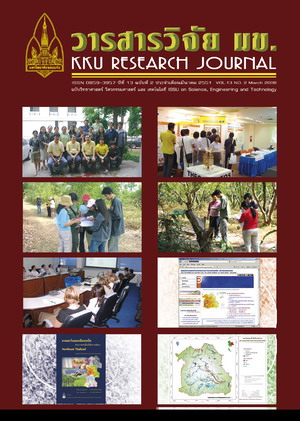Effect of chemical and physicochemica propertied of mixed rice on cooking qulity.(Thai)
Main Article Content
Abstract
The main cultivar Khao Dawk Mali 105 mixed with other varieties (Suphan Buri 60, Pathum-Thani
1, Chai-nat 1 and RD 23) with 20, 30 and 40 % were evaluated for chemical, physicochemical and cooking
properies. It was found that in mixed rice with Khao Dawk Mali 105, the amylose content of all treatments
were different (p≤0.05) but not different in lipid content (p>0.05). The protein content of mixed rice
Pathum-Thani 1 at all mix ratios, RD 23 (20%) and Chai-nat 1 (20%) are not different from Khao Dawk Mali 105 (p>0.05). Pathum-Thani 1 and Suphan-Buri 60 in mix ratios of 20, 30 and 40% and Chai-nat 130 %, the highest peak viscosity were not different with Khao Dawk Mali 105 (p>0.05). The relationship between different properties was determined using linear regression. (p≤0.05) Amylose content showed a positive correlation with peak viscosity, break down ,final viscosity, set back ,enthalpy of gelatinization, onset temperature, temperature at the end of gelatinization % retrogradation and cooking time water holding and hardness (R2 = 0.685, 0.575, 0.754, 0.497, 0.563, 0.697, 0.875, 0.756, 0.911 and 0.942) respectively. Protein content showed a positive correlation with set back enthalpy of gelatinization,%retragradation water holding and hardness
(R2=0.583 0.518 0.445,0462 and 0.814) respectively but amylose content showed a negative with peak viscosity cooking loss and stickiness R2=-0.563, -0.995 and-0.590 and protein content showed a negative correlation with cooking loss R2=-0.647. For sensory evaluation found that select Pathum-Thani 1 (all percentage mixed rate rice) Suphan-Buri 30 % and Chai-nat 1 20% had not deference likeness Khao Dawk Mali 105 in cooking properties. (p
≤0.05)
1, Chai-nat 1 and RD 23) with 20, 30 and 40 % were evaluated for chemical, physicochemical and cooking
properies. It was found that in mixed rice with Khao Dawk Mali 105, the amylose content of all treatments
were different (p≤0.05) but not different in lipid content (p>0.05). The protein content of mixed rice
Pathum-Thani 1 at all mix ratios, RD 23 (20%) and Chai-nat 1 (20%) are not different from Khao Dawk Mali 105 (p>0.05). Pathum-Thani 1 and Suphan-Buri 60 in mix ratios of 20, 30 and 40% and Chai-nat 130 %, the highest peak viscosity were not different with Khao Dawk Mali 105 (p>0.05). The relationship between different properties was determined using linear regression. (p≤0.05) Amylose content showed a positive correlation with peak viscosity, break down ,final viscosity, set back ,enthalpy of gelatinization, onset temperature, temperature at the end of gelatinization % retrogradation and cooking time water holding and hardness (R2 = 0.685, 0.575, 0.754, 0.497, 0.563, 0.697, 0.875, 0.756, 0.911 and 0.942) respectively. Protein content showed a positive correlation with set back enthalpy of gelatinization,%retragradation water holding and hardness
(R2=0.583 0.518 0.445,0462 and 0.814) respectively but amylose content showed a negative with peak viscosity cooking loss and stickiness R2=-0.563, -0.995 and-0.590 and protein content showed a negative correlation with cooking loss R2=-0.647. For sensory evaluation found that select Pathum-Thani 1 (all percentage mixed rate rice) Suphan-Buri 30 % and Chai-nat 1 20% had not deference likeness Khao Dawk Mali 105 in cooking properties. (p
≤0.05)
Article Details
How to Cite
Chuekaew, A., Srijesdaruk, V., & Uriyapongson, J. (2017). Effect of chemical and physicochemica propertied of mixed rice on cooking qulity.(Thai). Asia-Pacific Journal of Science and Technology, 13(2), 236–250. retrieved from https://so01.tci-thaijo.org/index.php/APST/article/view/83726
Section
Research Articles
References
-

